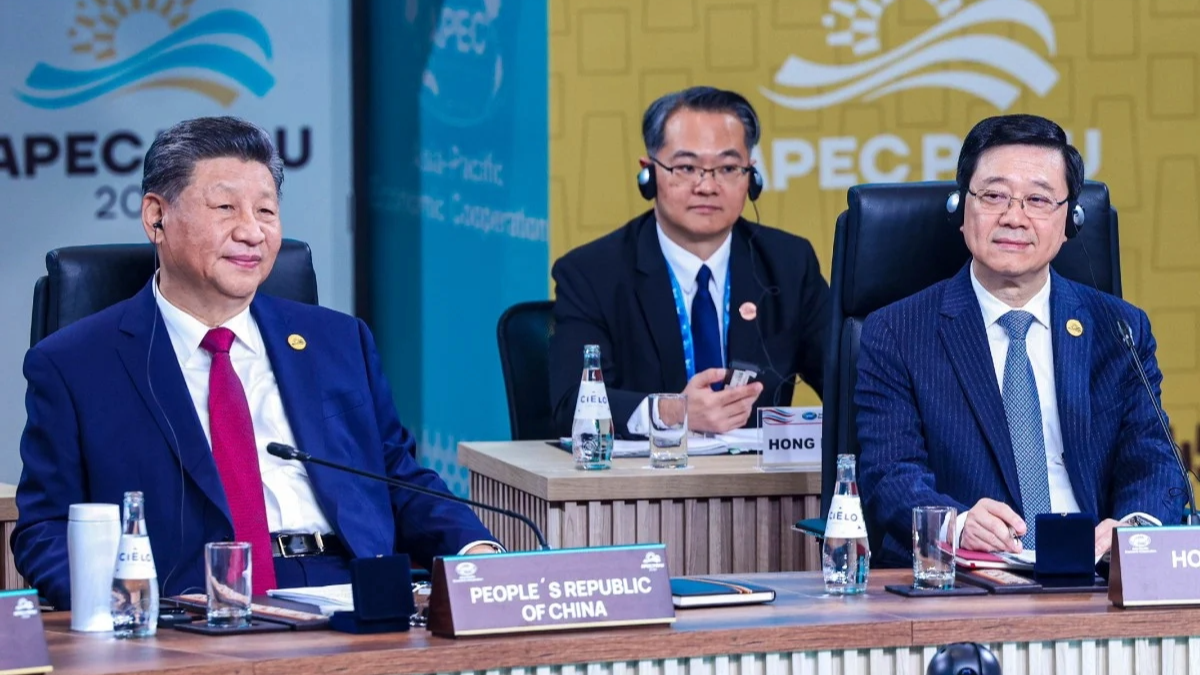China Picked Up the Ball on Data Trade Where the US Dropped It in 2024
Charles Mok / Jan 22, 2025
November 16, 2024: China President Xi Jinping (first left) and Hong Kong Chief Executive John Lee (first right) attend the 31st APEC Economic Leaders’ Meeting in Lima, Peru. Source
Will President Donald Trump take back global cross-border data flow agenda setting in 2025? That is the question.
In the 31st APEC Economic Leaders’ Meeting, held in Lima, Peru, in November 2024, Chinese President Xi Jinping stole the show from outgoing American President Joe Biden with a flurry of key economic cooperation announcements, including showing off China’s progress in strengthening alliances with Latin American countries. Xi’s remarks described his vision for an open and interconnected Asia Pacific with regional economic integration and stable supply chains, innovation in artificial intelligence, quantum computing, and green development, and furthering digital transformation.
While the media might have focused attention on Xi’s visit to the Chinese-financed Port of Chancay, which directly connects Peru with Shanghai, one important initiative announced at the Meeting was the Global Cross-Border Data Flow Cooperation Initiative, which, Xi said, would “seek deeper cooperation with other parties to promote efficient, convenient and secure cross-border data flows.”
While, at first glance, this may look to be at odds with China’s record of increasing stringent regulatory and institutional control over data flow and data localization requirements in recent years, it is part of China’s consistent effort to rewrite the rules of global data governance in its own terms. A closer look at the text of the initiative would reveal that, in spite of China’s proclamation to “uphold principles of openness, inclusiveness, security, cooperation, and non-discrimination,” it also notably advocates governments to “respect the regulatory differences of various countries and regions,” and to “respect the security measures taken by all countries in accordance with their laws to protect non-personal data related to national security and public interests.”
Interestingly, the initiative also calls for governments to “oppose overstretching the concept of national security on data issues,” and to “prohibit illicit acquisitions of data through methods such as setting up backdoors.” Again, on the surface, these proposals may look contradictory to what China has been suspected of conducting itself, but let’s not forget that China has never admitted to such behaviors, while Western countries have openly called for backdoors to encrypted systems in recent years, including the US, United Kingdom, and Australia. So, China’s current initiative is, in fact, not contradictory at all with what it has been saying, if not what it is doing, and highly consistent with its criticism of what the West has been both saying and doing.
This is not to say that China’s global data flow initiative does not face its own share of problems, starting with the confusion for foreign companies over how to comply with the country’s growing body of laws — from the Cybersecurity Law and Data Security Law to the Personal Information Protection Law — and regulations, such as the Outbound Data Transfer Assessment Measures. After years of these rules being in force, many aspects remain uncertain, from what is meant by “important data” to be regulated to “truly necessary” data that companies can claim legitimate grounds to transfer.
To China’s credit, its efforts and diligence have continuously helped it stride to improve the situation. Most recently, in January 2025, the country’s highest digital regulator, the Cyberspace Administration (CAC) of China, announced a consultation for the draft of personal information cross-border transfer and protection certification measures, which sets out the certification process for the transfer of personal information of 100,000 to 1 million individuals per year, or any “sensitive” personal information (such as biometric and health data) regardless of the number of subjects involved, not including “critical information” related to national security.
Recently, the National Data Administration (NDA) of China, established in 2023 to focus China’s ambition to develop its digital economy and artificial intelligence capabilities and outpace the West in setting data governance norms and standards, announced its plans to enhance the national data infrastructure by 2029, with a $54.5 billion investment per year for the next five years. One example of China’s attempt to establish global data governance precedence may be the accounting rules set by its Finance Ministry to enable the recording of data legally owned or controlled by firms on its balance sheet as inventory, intangible assets, or development expenditure, so as to create more values and financial incentives for firms to conduct data trade. China is pushing the concept to international discussions at the United Nations level.
Compared to China’s progressive data trade agenda in 2024, unfortunately for the US, which hosted the 2023 APEC Meeting in San Francisco a year before Peru, its efforts in setting digital trade alliances and norms had simply fallen flat on its face.
The idea of the Indo-Pacific Economic Framework for Prosperity (IPEF) was launched by President Joe Biden in May 2022 by the US with 13 partner countries across Asia Pacific to “pursue high-standard rules of the road in the digital economy, including standards on cross-border data flows and data localization,” clearly to also pre-empt and counter Chinese influence. However, the opportunity was squandered even before the IPEF ministers met in San Francisco in November 2023, as the US government decided then to postpone the IPEF talk on these “high-standard digital rules,” bowing to domestic, bipartisan pressure from politicians critical of digital firms, that is, the Big Tech.
Overall, the IPEF failed to produce anything of note in digital trade, labor rules, or environmental policies, except minor progress on matters like customer facilitation. It was hugely disappointing, especially considering the breadth of partners involved, from traditional allies like Australia, Japan, Korea, and New Zealand to strategically important and influential nations in the region’s geopolitical tug-of-war with China — India, Indonesia, Malaysia, the Philippines, Singapore, Thailand, and Vietnam. At about the same time, besides the IPEF impasse, the U.S. also dropped its longstanding demand for digital trade negotiation at the World Trade Organization (WTO), which would limit national requirements for data localization, as US Trade Representative Katherine Tai put it diplomatically, “to give Congress more room to regulate big tech firms.”
Indeed, the US digital data policy grew more inward in 2024. For instance, with the US’s longstanding inability to pass any comprehensive personal data protection law at the federal level, and facing the huge loophole of an unregulated domestic and global industry of data brokers selling Americans’ sensitive personal data (such as biometrics, health, geolocation, financial data) internationally, the Biden administration once again resorted to the issuance of an executive order to prohibit data brokers from transferring data to “countries of concern” — China, Cuba, Iran, North Korea, Russia and Venezuela. While the action was necessary, given the circumstances, the administration nonetheless had to defend itself from criticism that the executive order was not a departure from the G-7’s adopted principle of “data free flow with trust.”
Where China talks the high road of digital trade economic opportunities and creating global opportunities for its firms, the US retreats because its own politicians, across the aisle, want to regulate their own already global American firms, and yet, they actually haven’t even been able to even do that. This is where China has picked up the ball of data trade, right where the US has dropped it massively, and left open the room for China to position itself as a constructive leader and stakeholder in the data trade framework setting.
Already, countries in the Asia Pacific region– such as Australia, Japan, and Singapore–have taken upon themselves to develop and promote digital trade norms in the region. The US, with its “start-and-stop approach,” lost a lot of the trust and confidence of its regional partners and its leadership role after it walked away from the Trans-Pacific Partnership in 2017 and then also stalled the effort of the IPEF in 2023.
With President Donald Trump’s digital policy agenda largely unknown, the future for 2025 and beyond is still uncertain. Will the new administration’s close relationship with the big tech bosses and Silicon Valley mean lower resistance from Washington to taking on global data flow more aggressively? However, such kind of global trade pact to multilaterally regulate norms may not be Trump’s cup of tea, not to mention that as data flow is not the kind of tangible asset that can be easily tariffed, the topic may find it hard to be elevated to any meaningful level of attention by the new administration. But, with Trump’s new-found interest in building data centers in the US, albeit more from the understanding of a property developer, will he finally also “get it” that you also need a whole lot of data to flow to fill those data centers?
Like it or not, the free flow of data will also find its importance in satisfying the insatiable demand for more training data in the competition in generative artificial intelligence development. China’s cross-border data flow effort is undeniably more aggressive and visionary than anything that can be seen from the US and its allies, even given its authoritarian constraints, and has the possibility of going a long way toward setting a part of the agenda, norms and the future rules of the global data game, and some head start in building alliance relationship. Even the European Union launched its cross-border data flow communication mechanism with China for non-personal data for European businesses last year. On balance, China may have reasons to still feel positive about its data trade endeavors in the near future, given the incoming Trump administration’s turn toward isolationism.
Authors
